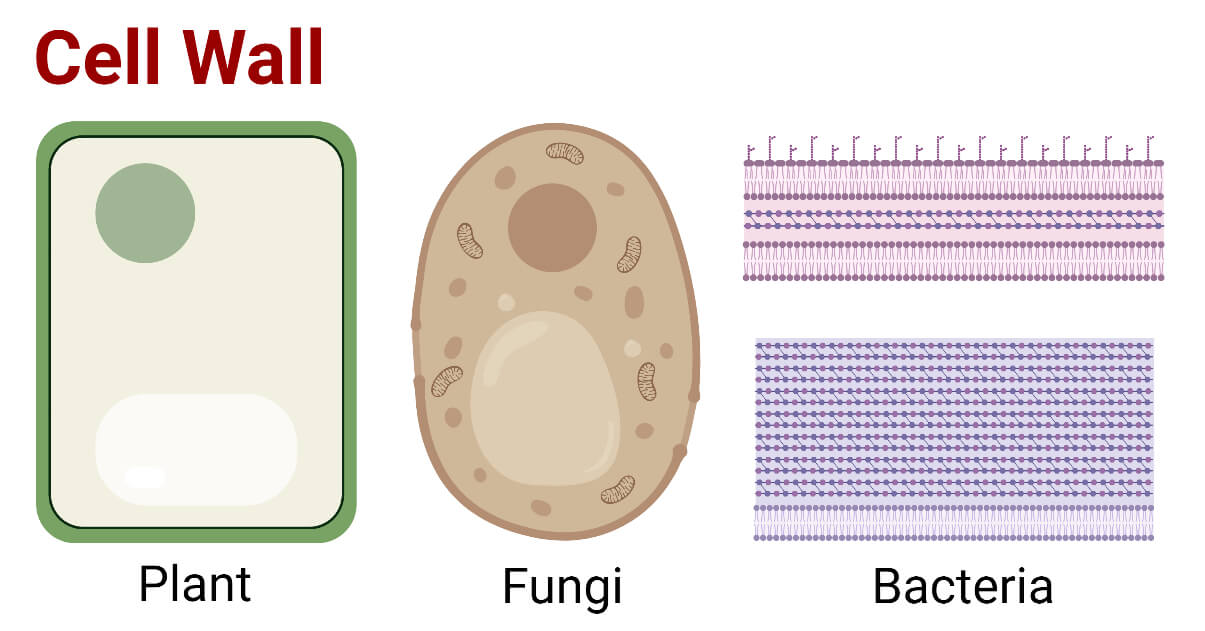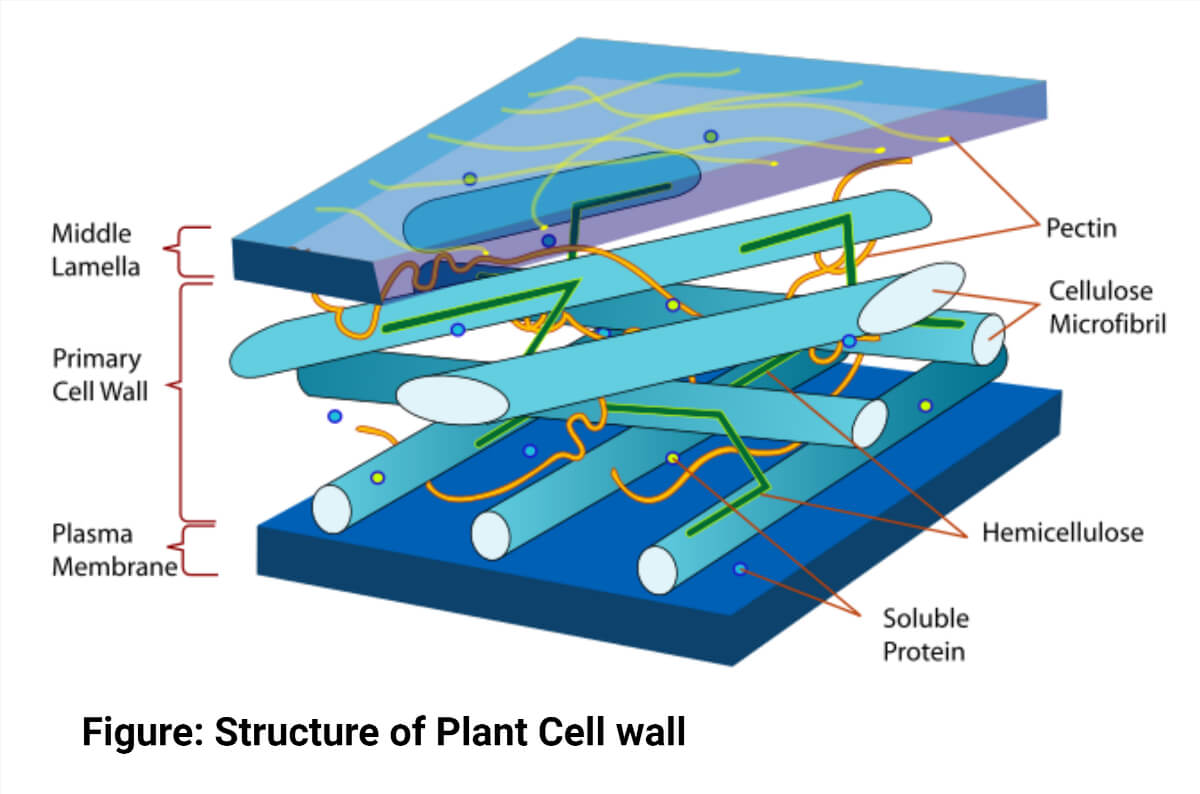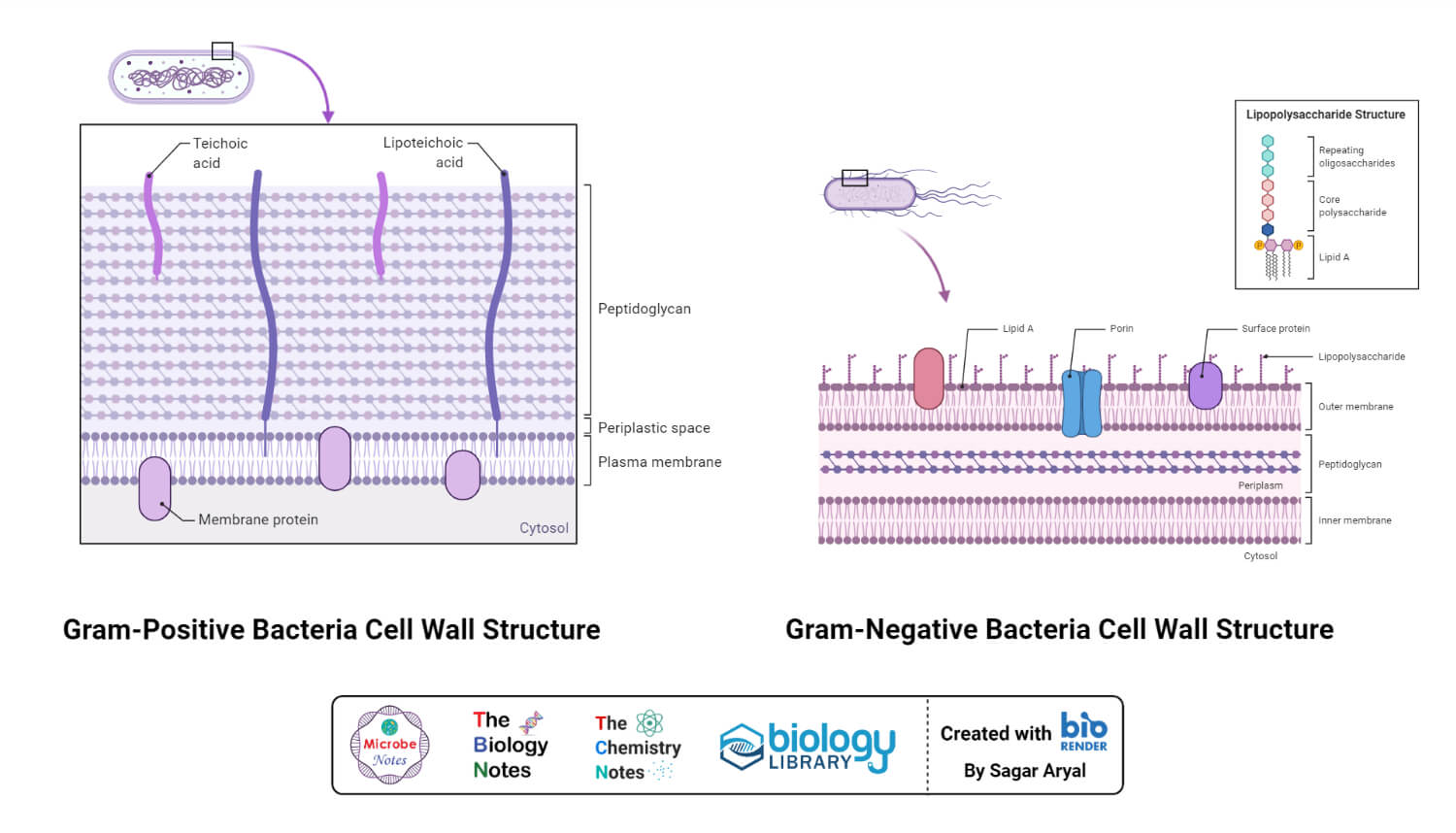The cell wall is a rigid and protective layer around the plasma membrane which provides mechanical support to the cell.
It is a non-living structure that is formed by the living protoplast.
Animal cells do not have a cell wall. They are present in most plant cells, fungi, bacteria, algae, and some archaea.
In-plant cells, the cell wall is made up of cellulose, hemicellulose, pectin, and protein. In many fungi, the cell wall is formed of chitin and in bacteria, the cell wall contains protein-lipid-polysaccharide complexes.
The cell wall has many important functions in a cell including protection, structure, and support.

Interesting Science Videos
Structure of Cell Wall (Plant, Fungal, Bacterial)
A rigid layer of polysaccharides enclosing the membrane of plant and prokaryotic cells; maintains the shape of the cell and serves as a protective barrier.
The Plant Cell Wall
- The plant cell wall is multi-layered and consists of up to three sections.
- From the outermost layer of the cell wall, these layers are identified as the middle lamella, primary cell wall, and secondary cell wall.
- While all plant cells have a middle lamella and primary cell wall, not all have a secondary cell wall.
- Middle lamella: This outer cell wall layer contains polysaccharides called pectins. Pectins aid in cell adhesion by helping the cell walls of adjacent cells to bind to one another.
- Primary cell wall:This layer is formed between the middle lamella and plasma membrane in growing plant cells. It is primarily composed of cellulose microfibrils contained within a gel-like matrix of hemicellulose fibers and pectin polysaccharides. The primary cell wall provides the strength and flexibility needed to allow for cell growth.
- Secondary cell wall:This layer is formed between the primary cell wall and plasma membrane in some plant cells. Once the primary cell wall has stopped dividing and growing, it may thicken to form a secondary cell wall. This rigid layer strengthens and supports the cell. In addition to cellulose and hemicellulose, some secondary cell walls contain lignin. Lignin strengthens the cell wall and aids in water conductivity in plant vascular tissue cells.

Fungal Cell Walls
The fungal cell wall is a matrix of three main components:
- Chitin
Polymers consisting mainly of unbranched chains of β-(1,4)-linked-N-Acetylglucosamine in the Ascomycota and Basidiomycota, or poly-β-(1,4)-linked-N-Acetylglucosamine (chitosan) in the Zygomycota. Both chitin and chitosan are synthesized and extruded at the plasma membrane.
- Glucans
Glucose polymers that function to cross-link chitin or chitosan polymers. β-glucans are glucose molecules linked via β-(1,3)- or β-(1,6)- bonds and provide rigidity to the cell wall while α-glucans are defined by α-(1,3)- and/or α-(1,4) bonds and function as part of the matrix.
- Proteins
Enzymes necessary for cell wall synthesis and lysis in addition to structural proteins are all present in the cell wall. Most of the structural proteins found in the cell wall are glycosylated and contain mannose, thus these proteins are called mannoproteins or mannans.
Bacterial Cell Wall
Bacterial cell walls are made of peptidoglycan (also called murein), which is made from polysaccharide chains cross-linked by unusual peptides containing D-amino acids.
- The structure of the cell wall is unique and is composed of disaccharide-pentapeptide subunits. The disaccharides
- N-acetylglucosamine and N-acetylmuramic acid are the alternating sugar components (moieties), with the amino acid chain linked to N-acetylmuramic acid molecules.
- Polymers of these subunits cross-link to one another by means of peptide bridges to form peptidoglycan sheets. In turn, layers of these sheets are cross-linked with one another, forming a multilayered, cross-linked structure of considerable strength. This peptidoglycan structure surrounds the entire cell.
- A notable difference between the cell walls of gram-positive and gram-negative bacteria is the substantially thicker peptidoglycan layer in gram-positive bacteria.
- Additionally, the cell wall of gram-positive bacteria contains teichoic acids (i.e., glycerol or ribitol phosphate polymers combined with various sugars, amino acids, and amino sugars).

Functions of the Cell Wall
- Support: The cell wall provides mechanical strength and support. It also controls the direction of cell growth.
- Withstand turgor pressure: Turgor pressure is the force exerted against the cell wall as the contents of the cell push the plasma membrane against the cell wall. This pressure helps a plant to remain rigid and erect, but can also cause a cell to rupture.
- Regulate growth: The cell wall sends signals for the cell to enter the cell cycle in order to divide and grow.
- Regulate diffusion: The cell wall is porous allowing some substances, including proteins, to pass into the cell while keeping other substances out.
- Communication: Cells communicate with one another via plasmodesmata (pores or channels between plant cell walls that allow molecules and communication signals to pass between individual plant cells).
- Protection: The cell wall provides a barrier to protect against plant viruses and other pathogens. It also helps to prevent water loss.
- Storage: The cell wall stores carbohydrates for use in plant growth, especially in seeds.
References
- Alberts, B. (2004). Essential cell biology. New York, NY: Garland Science Pub.
- Verma, P. S., & Agrawal, V. K. (2006). Cell Biology, Genetics, Molecular Biology, Evolution & Ecology (1 ed.). S .Chand and company Ltd.
- Tille, P. M., & Forbes, B. A. (2014). Bailey & Scott’s diagnostic microbiology (Thirteenth edition.). St. Louis, Missouri: Elsevier.
- Madigan, Michael T.; Martinko, John M.; Brock, Thomas D. (2005). Brock biology of microorganisms (11th ed.). Upper Saddle River, NJ: Pearson Prentice Hall.
- https://www.thoughtco.com/cell-wall-373613
- library.open.oregonstate.edu/microbiology/chapter/bacteria-cell-walls
- https://biology.tutorvista.com/animal-and-plant-cells/cell-wall.html

your website is really informational ….and thank you to your team.keep doing.best wishes.